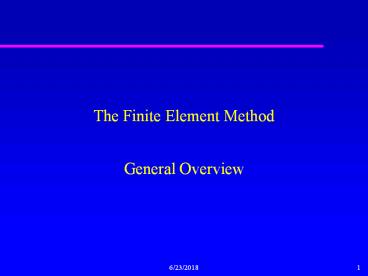The%20Finite%20Element%20Method - PowerPoint PPT Presentation
Title:
The%20Finite%20Element%20Method
Description:
Structure analysis (static/dynamic,linear/nonlinear) Thermal/fluid flows Electromagnetics Geomechanics Biomechanics. 3. General Overview. examples ... – PowerPoint PPT presentation
Number of Views:268
Avg rating:3.0/5.0
Title: The%20Finite%20Element%20Method
1
The Finite Element Method
- General Overview
2
General Overview
- widespread use in many engineering applications
- Applications of FEM in Engineering
- Mechanical/Aerospace/Civil/Automobile
Engineering - Structure analysis (static/dynamic,linear/nonlin
ear) - Thermal/fluid flows
- Electromagnetics
- Geomechanics
- Biomechanics
- ...
3
General Overview
- examples
- conduction heat transfer, solve for the
temperature distribution throughout the body with
known boundary conditions and material properties - fluid mechanics problems range from steady
inviscid incompressible flow to complex viscous
compressible flow,
4
General Overview
- acoustics uses finite element and boundary
element numerical methods - electromagnetic solution for magnetic field
strength provide insight to the design of
electromagnetic devices - capabilities extended to include fluid-structure
interactions, convective heat transfer - Bio-mechanics-bone structural analysis, blood
flow in blood vessels
5
General Overview
- Finite element method is a numerical method of
solving a system of governing equations over the
domain of a continuous physical system - method applies the many fields of science and
engineering - for engineering use, fields of continuum
mechanics and the theory of elasticity provide
the governing equations
6
(No Transcript)
7
For heat transfer, torsion of shafts,
irrotational flow, seepage through porous media
8
Solution of differential equation is tedious and
some times impossible
Complex geometry, boundary conditions, loading
conditions and material
9
General Overview
- Finite element method can be summarized in the
following steps - small parts called elements subdivide the domain
of the solid structure - elements assemble through interconnections at a
finite number of points (nodes) on each element - assembly provides a model of the structure
10
General Overview
- within each small domain, we assume a simple
general solution to the governing equations - solution for each element is a function of the
unknown solutions at the nodes
11
Fundamental concept of FEM
The fundamental concept of FEM is that continuous
function of a continuum (given domain ?) having
infinite degrees of freedom is replaced by a
discrete model, approximated by a set of
piecewise continuous function having a finite
degree of freedom.
12
(No Transcript)
13
General Overview
- sources of error
- assumed solution within the element is rarely the
exact solution - error between exact and assumed solution
- magnitude depends on the size of the elements
relative to the solution variation - in most cases, assumed solution converges to the
correct as element size decreases
14
General Overview
- all solid structures could be modeled with
three-dimensional solid elements, but for many
cases this is overkill - many structures can be simplified by making some
assumptions e.g. plane stress and plane strain
assumptions, simple beam theory
15
General Overview
- elements are categorized as either structural or
continuum - structural elements include trusses, beams,
plates and shells - formulations are based on same assumptions as in
their structural theories - finite element solution is no more accurate than
a solution using conventional beam or plate theory
16
General Overview
- continuum elements are two- and three dimensional
solid elements - formulation based on the theory of elasticity
(provides the governing equations for deformation
and stress) - Few closed form or numerical solutions exist for
these problems
17
Using a Computer Program
- 3 stages
- preprocessing
- processor
- postprocessing
18
Using a Computer Program
19
Using a Computer Program
- preprocessing
- create model
- nodal point locations
- element selection
- nodal connectivities
- material properties
- displacement boundary conditions
- loads and load cases
- preprocessor assembles data into a format for
execution
20
Using a Computer Program
- processor
- code that solves the system equations
- generates element stiffness matrices
- stores data in files
- assembles the structure stiffness matrix
- must provide enough displacement boundary
conditions to prevent rigid body motion - solution gives nodal displacements
- with element information, get strain and stress
21
Using a Computer Program
- postprocessing
- numeric output data difficult to use
- reduces data to graphic displays (contour plots,
graphs) - magnifies nodal displacements
- nodal displacements are single valued
- stress at a node can be multivalued if multiple
elements are attached to the node - (stress is found from within each element)
22
Re-analysis/redsign
- Postprocessing
- look at deformed displacements and check for
consistency with expected results - look at stresses and compare to approximate
solution
23
Re-analysis/redsign
- Refine model by considering the results of the
first analysis - high stress and rapid variations Þ reduce element
size - low stress Þ increase element size
- Redo analysis and check if results are converging
24
(No Transcript)
25
(No Transcript)
26
Re-analysis/redsign
- Figure 1-7 is a refined model of 1-6
- note how the maximum stress has increased
- convergence has not yet been achieved
- Serious mistake if only one model is analyzed
- Figure 1-6 is in error by 23, while Figure 1-7
is in error by 19 - There is no guarantee that results will be
accurate































